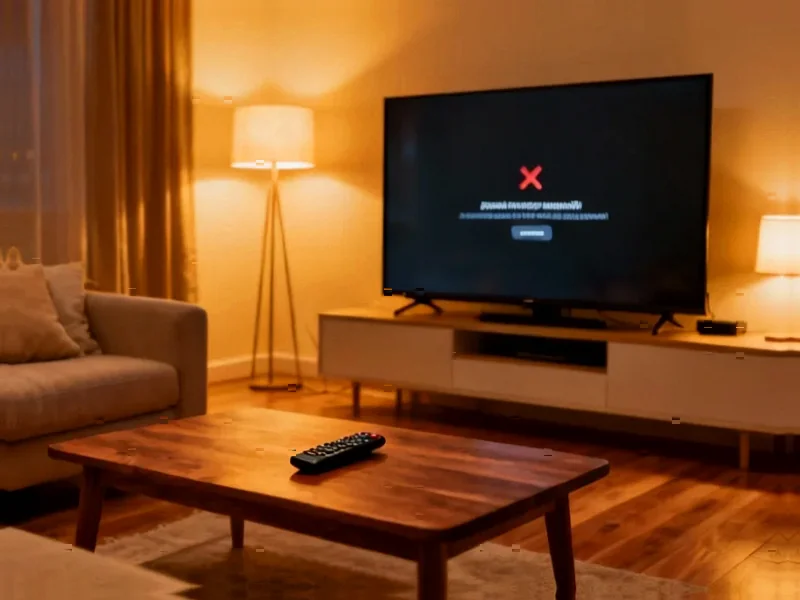According to Business Insider, Disney has enlisted top ESPN personalities including Stephen A. Smith, Scott Van Pelt, and Mike Greenberg to pressure YouTube TV subscribers amid a blackout that began on October 30. The dispute centers on Disney demanding what it calls “market rate” compensation for its networks, while YouTube TV claims the proposal would force another price increase while benefiting Disney-controlled rivals like Fubo and Hulu + Live TV. YouTube TV has promised subscribers a $20 credit if the blackout continues, while searches for “cancel YouTube TV” spiked to their highest level in five years according to Google Trends data. The timing is particularly problematic for sports fans who missed ESPN’s college football coverage and face potential disruption to “Monday Night Football” if the standoff continues.
The Technical Architecture Behind Modern Carriage Disputes
Modern streaming carriage disputes represent a fundamental shift from traditional cable negotiations. Unlike legacy systems where channel packages were negotiated months in advance, streaming platforms operate on more dynamic content delivery networks that can be reconfigured in near real-time. YouTube TV’s architecture allows for rapid channel removal and restoration, which ironically makes temporary blackouts more feasible as tactical maneuvers. The underlying technology involves complex content distribution networks, digital rights management systems, and adaptive bitrate streaming that must all be coordinated across multiple platforms. This technical flexibility means both parties can engage in brinkmanship knowing that restoration can happen almost instantly once terms are agreed.
The Psychology of Modern Media Consumption
What Disney may have underestimated is the fundamental shift in consumer psychology regarding streaming services. Unlike traditional cable subscribers who accepted carriage disputes as inevitable, streaming customers operate with a different mindset. The ease of cancellation—often just a few clicks—creates a lower tolerance for service disruptions. According to Google Trends data, search interest in canceling YouTube TV reached unprecedented levels, indicating that consumers view streaming as a fundamentally different proposition than traditional pay-TV. The psychological contract has changed: subscribers expect seamless access and immediate resolution of conflicts, not prolonged corporate standoffs.
ESPN’s Digital Transformation Dilemma
Disney’s deployment of ESPN talent through social media channels reveals the network’s broader strategic challenge. As Stephen A. Smith’s post, Scott Van Pelt’s message, and Mike Greenberg’s appeal demonstrate, ESPN is attempting to leverage its talent relationships to influence consumer behavior. However, this strategy risks damaging the very direct-to-consumer relationships ESPN needs to build for its standalone streaming future. The backlash against these personalities suggests that audiences increasingly distinguish between the talent they enjoy and the corporate entities they represent. This creates a delicate balancing act for networks transitioning from wholesale content providers to direct consumer services.
The Technical Reality of Sports Fragmentation
The underlying technical infrastructure of modern sports distribution creates inherent tension in these disputes. Unlike the broadcast era where games were available over public airwaves, today’s sports content requires sophisticated streaming infrastructure, content delivery networks, and authentication systems. The Disney position statement highlights how rights fees have exploded, with the NBA securing a $76 billion deal versus its previous $24 billion agreement. This cost structure forces difficult technical decisions: either build expensive direct-to-consumer platforms or rely on aggregation services that must absorb these costs. The technical complexity of delivering high-quality live sports at scale means there are no simple solutions to this economic challenge.
The Technical Ease of Modern Piracy
Perhaps the most concerning technical development for both parties is the sophistication of modern sports piracy. Unlike the analog era of fuzzy broadcast signals, today’s illegal streaming services often provide high-quality, low-latency streams that rival legitimate services. The technical barriers to accessing pirated content have dramatically lowered, with many illegal streams requiring just a web browser rather than specialized software. When frustrated fans in the social media responses threatened to turn to pirate sites, they weren’t bluffing—the technical infrastructure to deliver quality illegal streams has become remarkably accessible. This represents an existential threat to the entire sports media economy that neither Disney nor Google can afford to ignore.
Strategic Implications for the Streaming Ecosystem
The technical and consumer behavior patterns revealed in this dispute suggest broader industry implications. The spike in search interest for competing services indicates that consumers now treat streaming as a commodity service with low switching costs. This fundamentally changes the leverage dynamics in carriage negotiations. Unlike cable era disputes where subscribers faced significant barriers to switching, streaming services operate in an environment where customer loyalty is exceptionally fragile. The technical architecture that makes streaming services easy to join also makes them easy to leave, creating permanent pressure on both content owners and distribution platforms to avoid disruptions that trigger mass cancellations.




